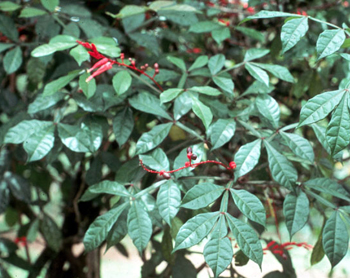Contents:
Common Names | Parts Usually Used | Plant(s) & Culture | Where Found | Medicinal Properties
Legends, Myths and Stories | Uses | Formulas or Dosages | How Sold | Bibliography
Scientific Names

- Picraena excelsa L.
- Quassia family
Common Names
- Bitter ash
- Bitter bark
- Bitter quassia
- Bitter wood
- Lofty quassia
- Quassia bark
- Quassia wood
Parts Usually Used
Wood, bark
Back to Top
Description of Plant(s) and Culture
The quassia tree grows from 50 to 100 feet high; it has smooth, gray bark and alternate, odd-pinnate leaves with oblong, pointed leaflets. Its small flowers are yellowish or greenish, its fruit is a small rupe about the size of a pea.
Back to Top
Where Found
A native of tropical America and the West Indies. A small tree native of Surinam and Guiana being introduced to the West Indies.
Back to Top
Medicinal Properties
Anthelmintic, febrifuge, stomachic, bitter tonic
Back to Top
Legends, Myths and Stories
Quassia is a common component of insecticides.
A pure bitter with no sensible odor, Quassia cups were once very popular, and obtainable in drug stores. They were a sort of wooden cup or goblet, make of Quassia wood, for the purpose of drinking out of, to obtain the properties of the wood, which is so bitter, and yields its properties so readily to water, that if water is allowed to remain a few minutes in the cup, it will become quite bitter. What is most singular, this bitter principle seems almost inexhaustible. Quassia chips are used to discourage thumb sucking among children. The decoction is applied to the thumb or finger usually sucked. Renew applications according to persistence of the child. Unlike Capsicum, which is sometimes used in preparations to discourage thumb sucking, tea of quassia chips will not burn the eyes when the child happens to come in such contact.
Quassia chips, an intense bitter, is used in aperitifs and sometimes as a substitute for hops in making beer. In Europe it is used in tonic wines.
The generic name Quassia is derived from a man named Quassi of Surinam, who employed the wood with uncommon success as a secret remedy in the malignant endemic fevers which frequently prevails in Surinam. He sold the secret to Daniel Rolander, a Swede, who in 1756 took specimens of the wood to Stockholm, and shortly afterwards it became highly extolled throughout Europe, and it has been prescribed by numerous eminent doctors as an excellent stomachic tonic. The whole plant; root, wood, and bark, is intensely bitter.
Quassia is used in hair lotions. An old-fashioned plant spray to drive off plant lice was made with a strong decoction of Quassia mixed with liquid soap. A strong infusion sweetened and placed in a saucer is used to kill flies. This is harmless to house pets.
Steep 1 pint of quassia chips for 1 hour or more in a gallon of hot water. Add to this 1 pint of softened strong laundry soap and another gallon of water. Beat until you have strong suds. Add 1 tsp. of kerosene and demulsify thoroughly. Then add another two gallons of water and apply with a good brass syringe through a fine nozzle. This is a sure mealybug killer.
To repel gnats, put a handful of Quassia chips into a bowl of cold water, leaving for 12 hours or longer. Bottle, and for use, sponge the exposed skin with the liquid. The bitter taste is a preventive.
Uses
An infusion of the wood has been used for fever, rheumatism, and dyspepsia. Taken internally, it kills roundworms, and as an enema it kills pinworms. The tea is said to destroy appetite for alcohol. Water left standing overnight in a cup made from quassia wood becomes a weak infusion suitable as a bitter tonic for the stomach. An infusion serves as a scalp rinse to counteract dandruff.
Back to Top
Formulas or Dosages
Infusion: steep 1 tsp. quassia wood in 1 cup boiling water. Take 1 cup per day. Also, an infusion may be made by 1 oz. of wood chips or shavings in 1 qt. cold water; let stand for 12 hours; the dose is about 1/2 tsp. 3 times a day. A little ginger, cloves, lemon peel or warm aromatic may be added to render the infusion more palatable.
Tincture: a dose is from 2 to 5 drops.
Back to Top
How Sold
Tincture or powder
Back to Top
Bibliography
![]() Back to Eden
Back to Eden, by Jethro Kloss; Back to Eden Publishing Co., Loma Linda, CA 92354, Original copyright 1939, revised edition 1994
![]() The Complete Medicinal Herbal
The Complete Medicinal Herbal, by Penelope Ody, Dorling Kindersley, Inc, 232 Madison Avenue, New York, NY 10016, First American Edition, copyright 1993
![]() The Herbalist Almanac
The Herbalist Almanac, by Clarence Meyer, Meyerbooks, publisher, PO Box 427, Glenwood, Illinois 60425, copyright 1988, fifth printing, 1994
![]() The Herb Book
The Herb Book, by John Lust, Bantam Books, 666 Fifth Avenue, New York, NY. copyright 1974.
 Old Ways Rediscovered
Old Ways Rediscovered, by Clarence Meyer, Meyerbooks, publisher, PO Box 427, Glenwood, Illinois 60425, published from 1954, print 1988
![]() Webster’s New World Dictionary
Webster’s New World Dictionary, Third College Edition, Victoria Neufeldt, Editor in Chief, New World Dictionaries: A Division of Simon & Schuster, Inc., 15 Columbus Circle, New York, NY 10023
